Mapping Contaminant Plume at a Landfill in a Crystalline Basement Terrain in Ouagadougou, Burkina Faso, Using Self-Potential Geophysical Technique
Abstract
1. Introduction
2. Materials and Methods
2.1. The Study Area
2.2. Self-Potential Data Acquisition
2.3. Data Treatment
3. Results
4. Discussion
4.1. Reliability of Data and Mapping
4.2. Structure of the Distribution of Self-Potential Values
5. Conclusions and Future Directions
Author Contributions
Funding
Data Availability Statement
Conflicts of Interest
References
- Sako, A.; Bamba, O.; Gordio, A. Hydrogeochemical processes controlling groundwater quality around Bomboré gold mineralized zone, Central Burkina Faso. J. Geochem. Explor. 2016, 170, 58–71. [Google Scholar] [CrossRef]
- El Mouine, Y.; El Hamdi, A.; Morarech, M.; Kacimi, I.; Touzani, M.; Mohsine, I.; Tiouiouine, A.; Ouardi, J.; Zouahri, A.; Yachou, H.; et al. Landfill Pollution Plume Survey in the Moroccan Tadla Using Spontaneous Potential. Water 2021, 13, 910. [Google Scholar] [CrossRef]
- Clément, R.; Oxarango, L.; Descloitres, M. Contribution of 3-D time-lapse ERT to the study of leachate recirculation in a landfill. Waste Manag. 2011, 31, 457–467. [Google Scholar] [CrossRef] [PubMed]
- Gallas, J.D.F. Método Do Potencial Espontâneo (SP) Uma revisão sobre suas causas, seu uso histórico e suas aplicações atuais. Rev. Bras. Geofísica 2005, 23, 133–144. [Google Scholar] [CrossRef]
- Gallas, J.D.F.; Taioli, F.; Malagutti Filho, W. Induced polarization, resistivity, and self-potential: A case history of contamination evaluation due to landfill leakage. Environ. Earth Sci. 2011, 63, 251–261. [Google Scholar] [CrossRef]
- Revil, A.; Jardani, A. The Self-Potential Method: Theory and Applications in Environmental Geosciences; Cambridge University Press: New York City, NY, USA, 2013; ISBN 978-1-107-01927-0. [Google Scholar]
- Jouniaux, L.; Maineult, A.; Naudet, V.; Pessel, M.; Sailhac, P. Review of self-potential methods in hydrogeophysics. Comptes Rendus Geosci. 2009, 341, 928–936. [Google Scholar] [CrossRef]
- Schüring, J.; Schlieker, M.; Hencke, J. Redox Fronts in Aquifer Systems and Parameters Controlling their Dimensions. In Redox: Fundamentals, Processes and Applications; Schüring, J., Schulz, H.D., Fischer, W.R., Böttcher, J., Duijnisveld, W.H.M., Eds.; Springer: Berlin/Heidelberg, Germany, 2000; pp. 135–151. ISBN 978-3-662-04080-5. [Google Scholar]
- Senos Matias, M.; Marques da Silva, M.; Ferreira, P.; Ramalho, E. A geophysical and hydrogeological study of aquifers contamination by a landfill. J. Appl. Geophys. 1994, 32, 155–162. [Google Scholar] [CrossRef]
- Giang, N.V.; Kochanek, K.; Vu, N.T.; Duan, N.B. Landfill leachate assessment by hydrological and geophysical data: Case study NamSon, Hanoi, Vietnam. J. Mater. Cycles Waste Manag. 2018, 20, 1648–1662. [Google Scholar] [CrossRef]
- Weigel, M. Self-potential surveys on waste dumps theory and practice. In Detection of Subsurface Flow Phenomena; Merkler, G.-P., Militzer, H., Hötzl, H., Armbruster, H., Brauns, J., Eds.; Springer: Berlin/Heidelberg, Germany, 1989; pp. 109–120. [Google Scholar]
- Revil, A.; Cary, L.; Fan, Q.; Finizola, A.; Trolard, F. Self-potential signals associated with preferential ground water flow pathways in a buried paleo-channel. Geophys. Res. Lett. 2005, 32. [Google Scholar] [CrossRef]
- Mao, D.; Revil, A.; Hort, R.D.; Munakata-Marr, J.; Atekwana, E.A.; Kulessa, B. Resistivity and self-potential tomography applied to groundwater remediation and contaminant plumes: Sandbox and field experiments. J. Hydrol. 2015, 530, 1–14. [Google Scholar] [CrossRef]
- Touzani, M. Etude D’impact de Décharge d’oum Azza sur les Ressources en Eaux Souterraines du Secteur Oum Azza-Ain EL Aouda (Région RABAT-MAROC); Mohamed V University: Rabat, Morocco, 2020. [Google Scholar]
- Naudet, V.; Revil, A.; Rizzo, E.; Bottero, J.-Y.; Bégassat, P. Groundwater redox conditions and conductivity in a contaminant plume from geoelectrical investigations. Hydrol. Earth Syst. Sci. 2004, 8, 8–22. [Google Scholar] [CrossRef]
- Naudet, V.; Revil, A.; Bottero, J.-Y.; Bégassat, P. Relationship between self-potential (SP) signals and redox conditions in contaminated groundwater. Geophys. Res. Lett. 2003, 30. [Google Scholar] [CrossRef]
- Atekwana, E.A.; Slater, L.D. Biogeophysics: A new frontier in Earth science research. Rev. Geophys. 2009, 47. [Google Scholar] [CrossRef]
- Hämmann, M.; Maurer, H.R.; Green, A.G.; Horstmeyer, H. Self-Potential Image Reconstruction: Capabilities and Limitations. J. Environ. Eng. Geophys. 1997, 2, 21–35. [Google Scholar] [CrossRef]
- Nyquist, J.E.; Corry, C.E. Self-potential: The ugly duckling of environmental geophysics. Lead. Edge 2002, 21, 446–451. [Google Scholar] [CrossRef]
- Audebert, M.; Clément, R.; Moreau, S.; Duquennoi, C.; Loisel, S.; Touze-Foltz, N. Understanding leachate flow in municipal solid waste landfills by combining time-lapse ERT and subsurface flow modelling—Part I: Analysis of infiltration shape on two different waste deposit cells. Waste Manag. 2016, 55, 165–175. [Google Scholar] [CrossRef] [PubMed]
- Perrier, F.; Froidefond, T. Electrical conductivity and streaming potential coefficient in a moderately alkaline lava series. Earth Planet. Sci. Lett. 2003, 210, 351–363. [Google Scholar] [CrossRef]
- Revil, A.; Naudet, V.; Nouzaret, J.; Pessel, M. Principles of electrography applied to self-potential electrokinetic sources and hydrogeological applications. Water Resour. Res. 2003, 39, 1–15. [Google Scholar] [CrossRef]
- Ouandaogo-Yameogo, S.; Blavoux, B.; Nikiema, J.; Savadogo, A. Caractérisation du fonctionnement des aquifères de socle dans la région de Ouagadougou à partir d’une étude de la qualité chimique des eaux. Rev. des Sci. l’eau/J. Water Sci. 2013, 26, 173–191. [Google Scholar] [CrossRef]
- Ouandaogo-Yaméogo, S. Ressources en eau souterraine du centre urbain de Ouagadougou au Burkina Faso, qualité et vulnérabilité. Ph.D. Thesis, Avignon University, Avignon, France, 2008. [Google Scholar]
- Petiau, G. Second Generation of Lead-lead Chloride Electrodes for Geophysical Applications. Pure Appl. Geophys. 2000, 157, 357–382. [Google Scholar] [CrossRef]
- Jougnot, D.; Linde, N. Self-Potentials in Partially Saturated Media: The Importance of Explicit Modeling of Electrode Effects. Vadose Zone J. 2013, 12, vzj2012.0169. [Google Scholar] [CrossRef]
- Barbiero, L.; Cunnac, S.; Mané, L.; Laperrousaz, C.; Hammecker, C.; Maeght, J.L. Salt distribution in the Senegal middle valley analysis of a saline structure on planned irrigation schemes from N’Galenka creek. Agric. Water Manag. 2001, 46, 201–213. [Google Scholar]
- Jardani, A.; Revil, A.; Barrash, W.; Crespy, A.; Rizzo, E.; Straface, S.; Cardiff, M.; Malama, B.; Miller, C.; Johnson, T. Reconstruction of the water table from self-potential data: A bayesian approach. Ground Water 2009, 47, 213–227. [Google Scholar] [CrossRef] [PubMed]
- Aubert, M.; Atangana, Q.Y. Self-Potential Method in Hydrogeological Exploration of Volcanic Areas. Groundwater 2018, 34, 1010–1016. [Google Scholar] [CrossRef]
- Revil, A.; Mendonça, C.A.; Atekwana, E.A.; Kulessa, B.; Hubbard, S.S.; Bohlen, K.J. Understanding biogeobatteries: Where geophysics meets microbiology. J. Geophys. Res. Biogeosci. 2010, 115. [Google Scholar] [CrossRef]
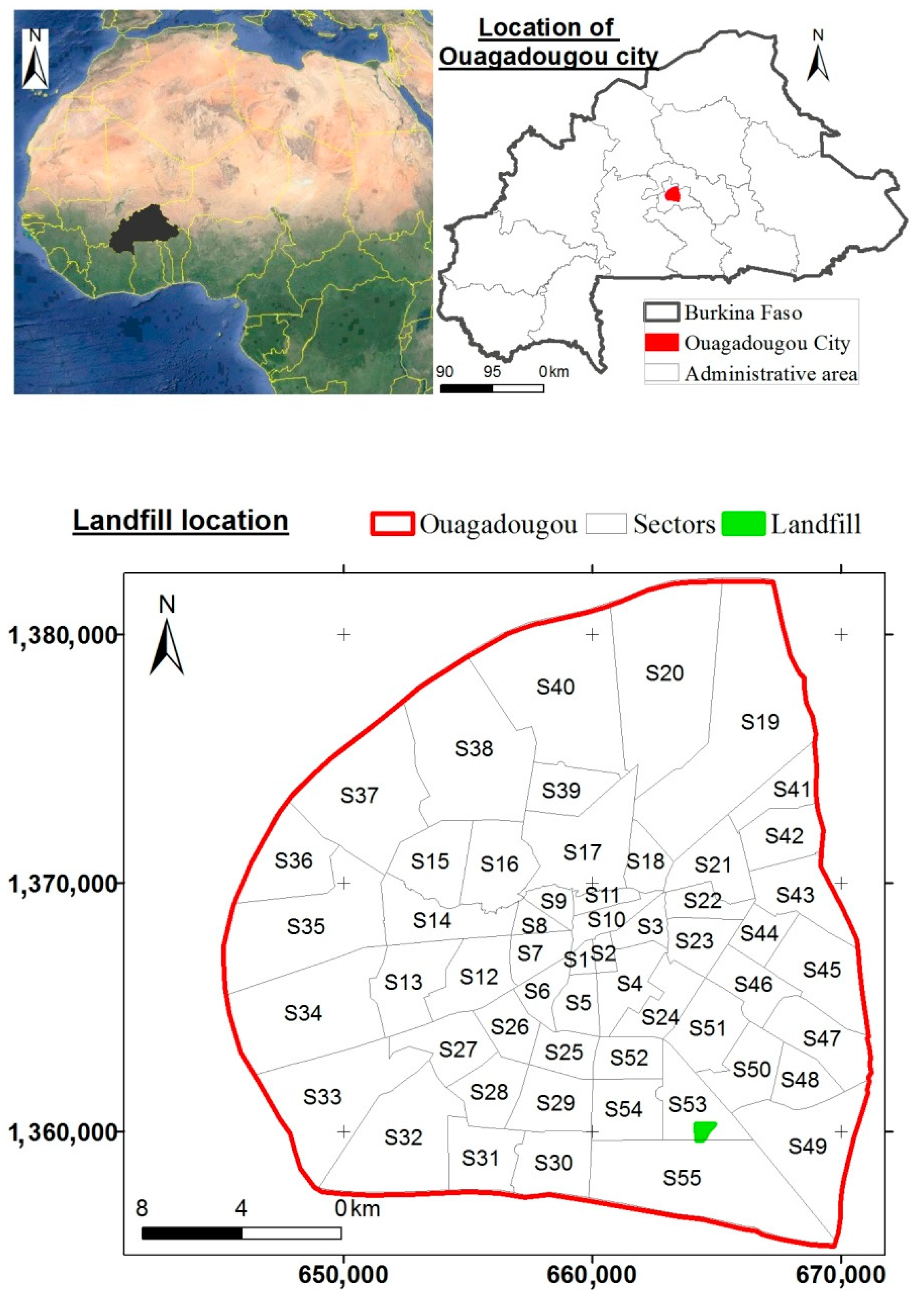

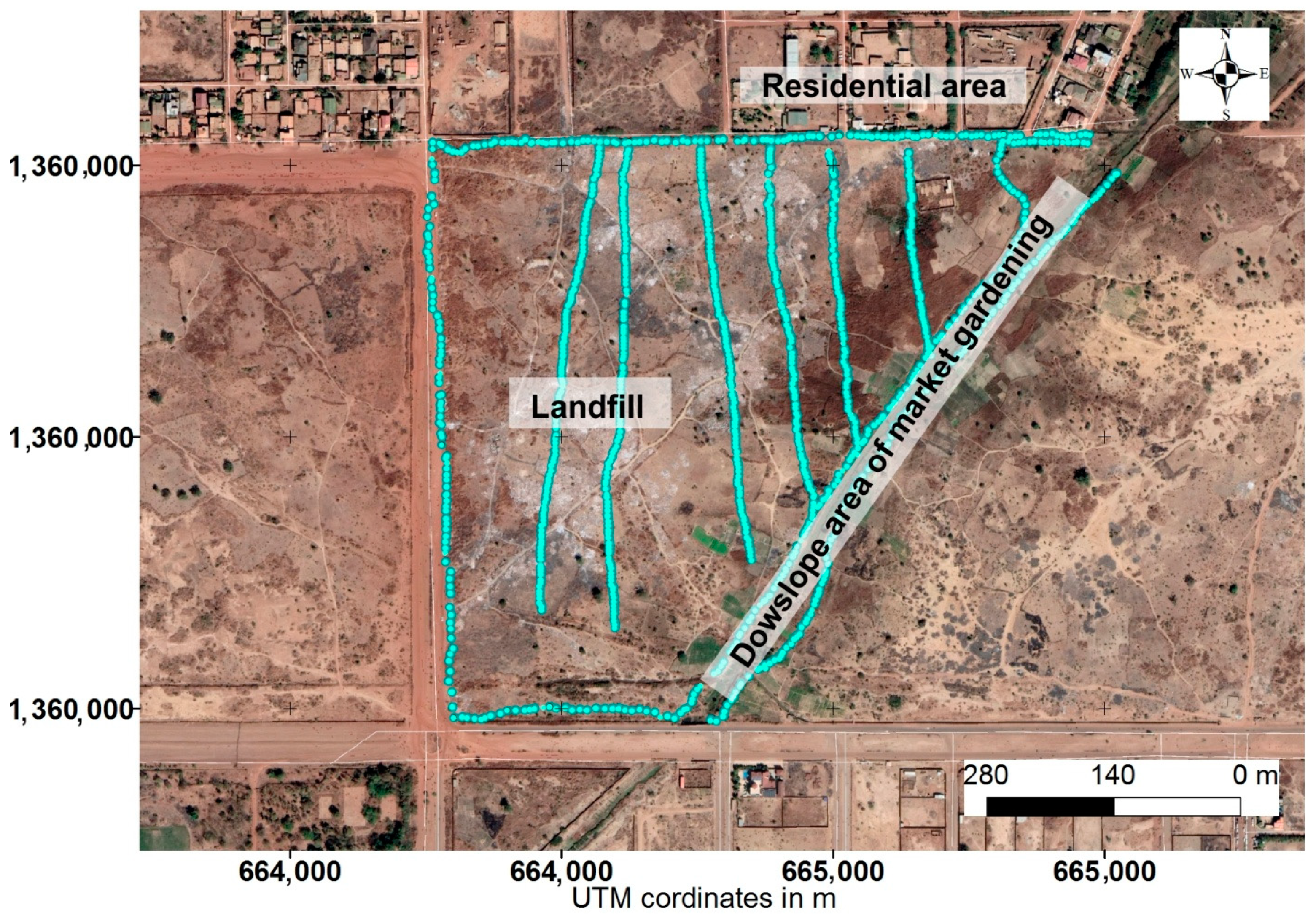
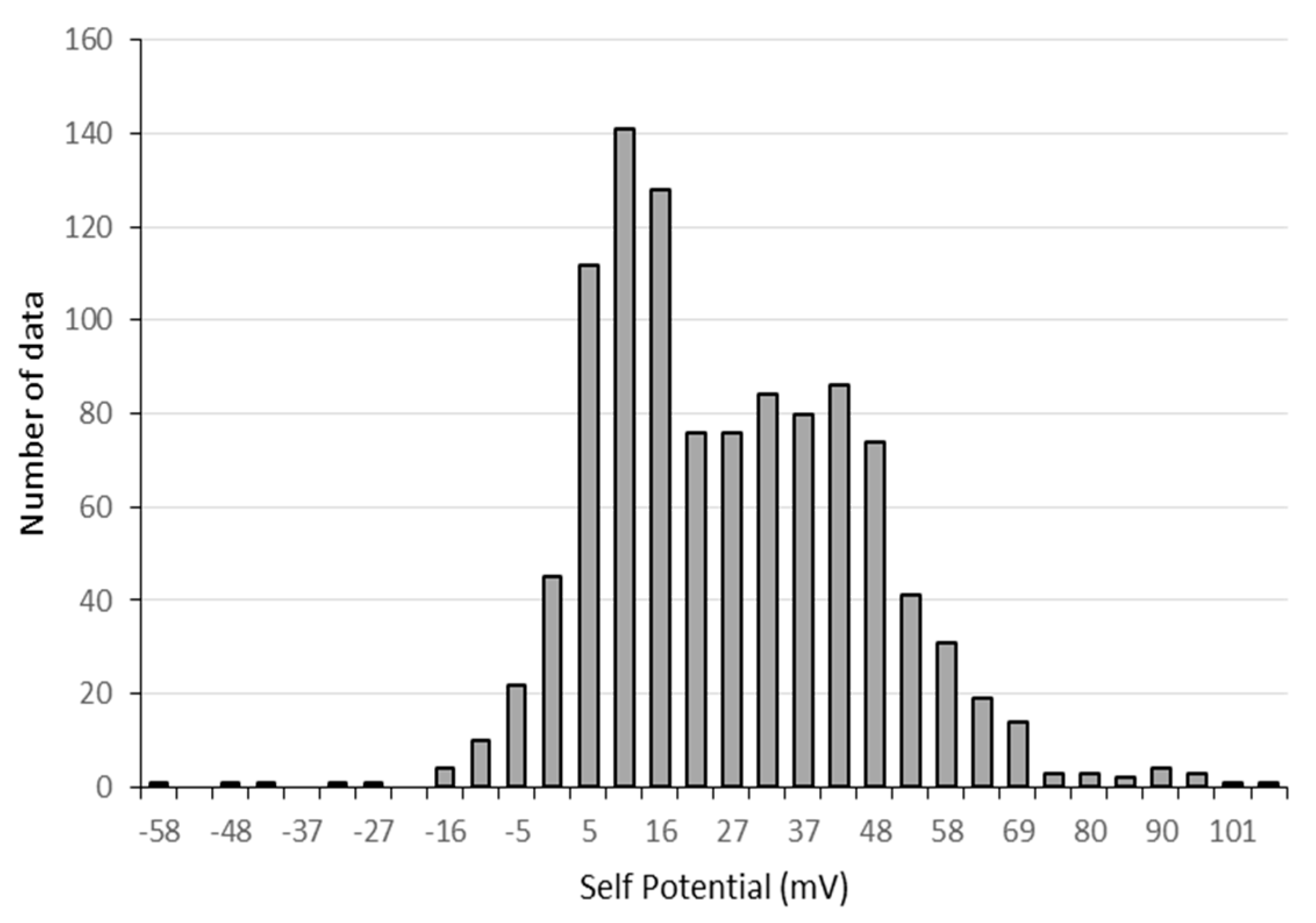
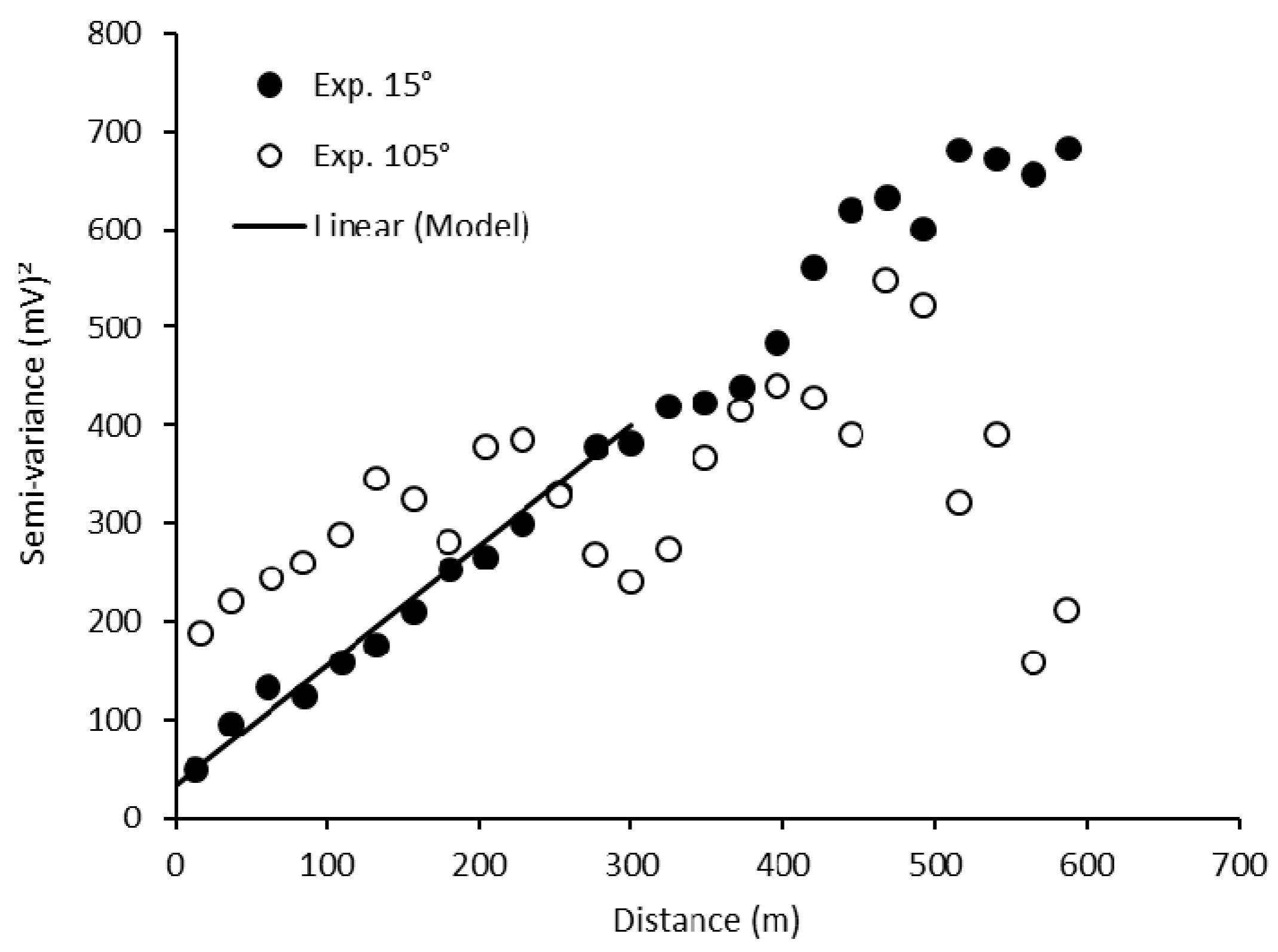
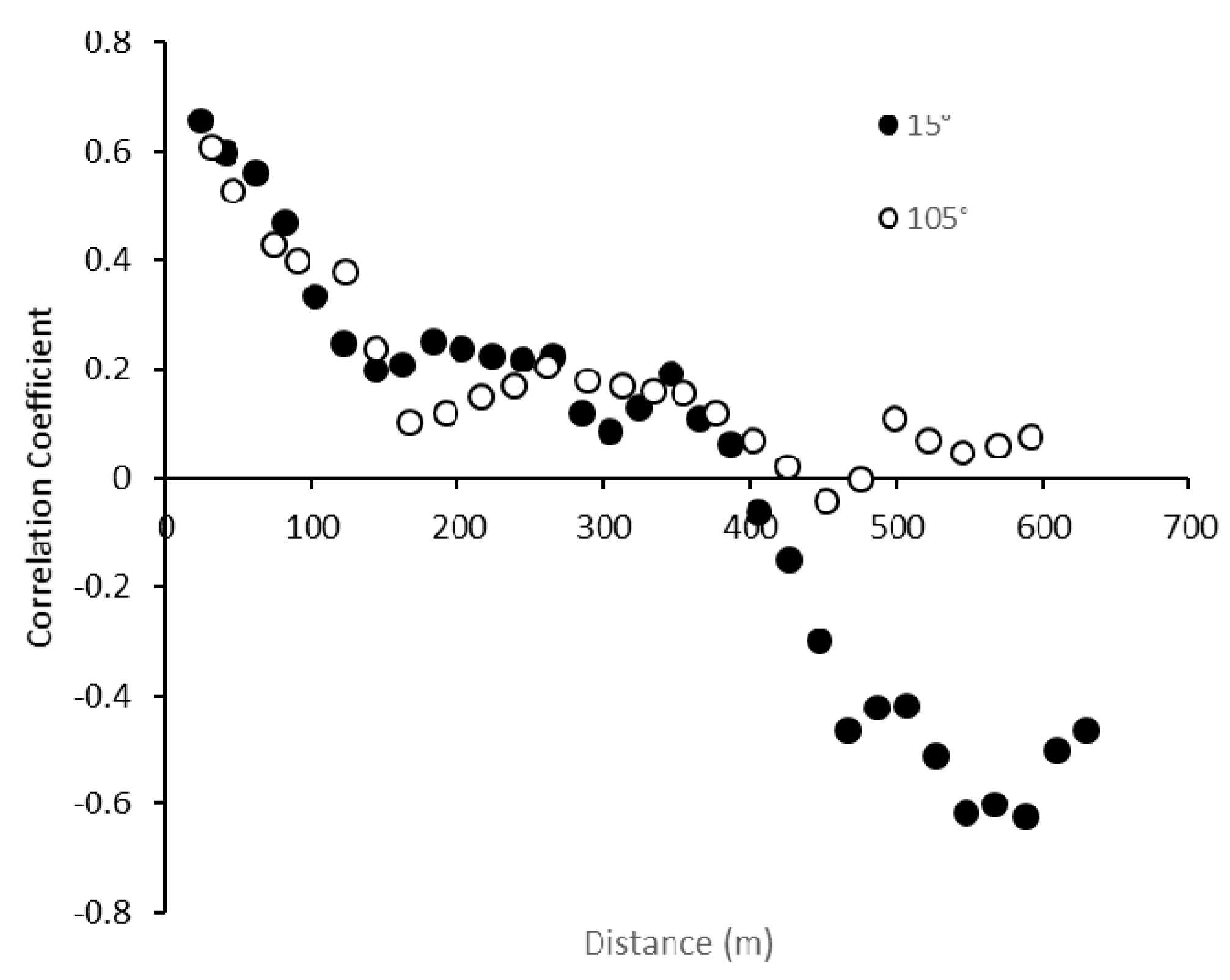
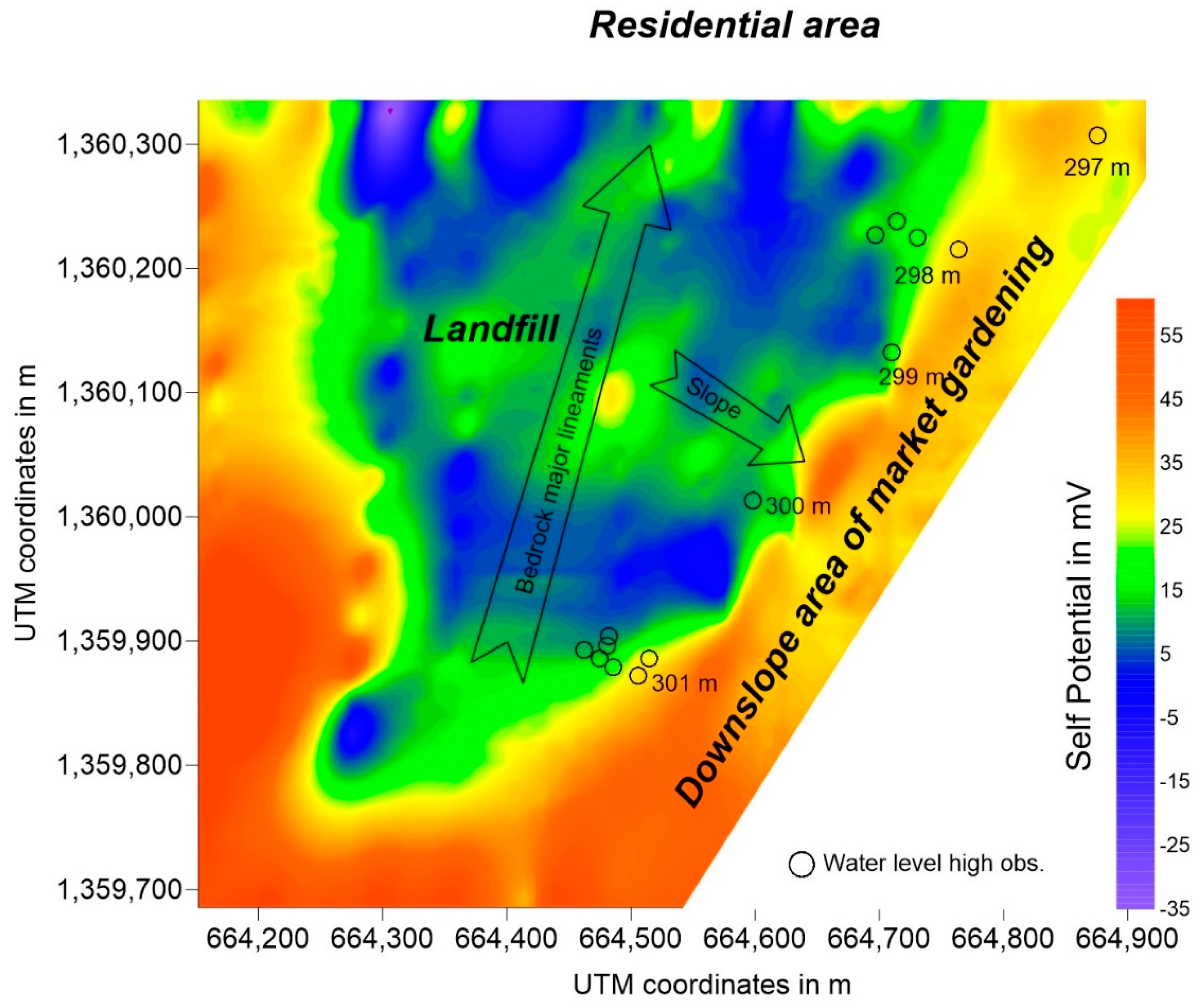

Publisher’s Note: MDPI stays neutral with regard to jurisdictional claims in published maps and institutional affiliations. |
© 2021 by the authors. Licensee MDPI, Basel, Switzerland. This article is an open access article distributed under the terms and conditions of the Creative Commons Attribution (CC BY) license (https://creativecommons.org/licenses/by/4.0/).
Share and Cite
Barry, A.A.; Yameogo, S.; Ayach, M.; Jabrane, M.; Tiouiouine, A.; Nakolendousse, S.; Lazar, H.; Filki, A.; Touzani, M.; Mohsine, I. Mapping Contaminant Plume at a Landfill in a Crystalline Basement Terrain in Ouagadougou, Burkina Faso, Using Self-Potential Geophysical Technique. Water 2021, 13, 1212. https://doi.org/10.3390/w13091212
Barry AA, Yameogo S, Ayach M, Jabrane M, Tiouiouine A, Nakolendousse S, Lazar H, Filki A, Touzani M, Mohsine I. Mapping Contaminant Plume at a Landfill in a Crystalline Basement Terrain in Ouagadougou, Burkina Faso, Using Self-Potential Geophysical Technique. Water. 2021; 13(9):1212. https://doi.org/10.3390/w13091212
Chicago/Turabian StyleBarry, Abdoul Azize, Suzanne Yameogo, Meryem Ayach, Meryem Jabrane, Abdessamad Tiouiouine, Samuel Nakolendousse, Hajar Lazar, Ahlam Filki, Meryem Touzani, and Ismail Mohsine. 2021. "Mapping Contaminant Plume at a Landfill in a Crystalline Basement Terrain in Ouagadougou, Burkina Faso, Using Self-Potential Geophysical Technique" Water 13, no. 9: 1212. https://doi.org/10.3390/w13091212
APA StyleBarry, A. A., Yameogo, S., Ayach, M., Jabrane, M., Tiouiouine, A., Nakolendousse, S., Lazar, H., Filki, A., Touzani, M., & Mohsine, I. (2021). Mapping Contaminant Plume at a Landfill in a Crystalline Basement Terrain in Ouagadougou, Burkina Faso, Using Self-Potential Geophysical Technique. Water, 13(9), 1212. https://doi.org/10.3390/w13091212




